SOVIET SPACE DREAMS:
КОСМИЧЕСКИЕ

КОСМИЧЕСКИЕ
И ОГРАНИЧЕНИЯ МАШИННОГО ОБУЧЕНИЯ

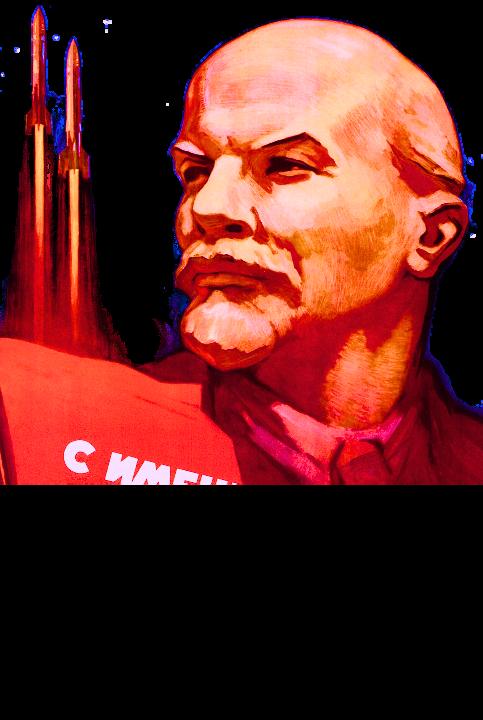
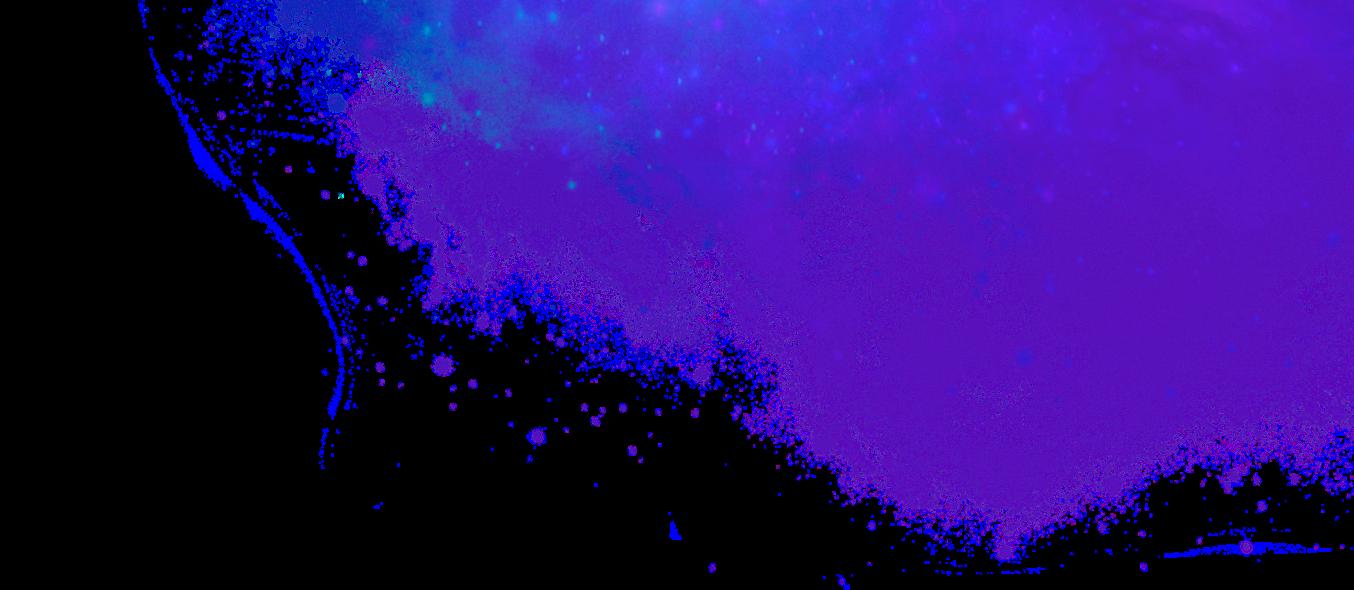
What does analyzing Soviet propaganda, imagery created to promote a specific political vision, through machine learning reveal about the assumptions and blind spots built into the models themselves?
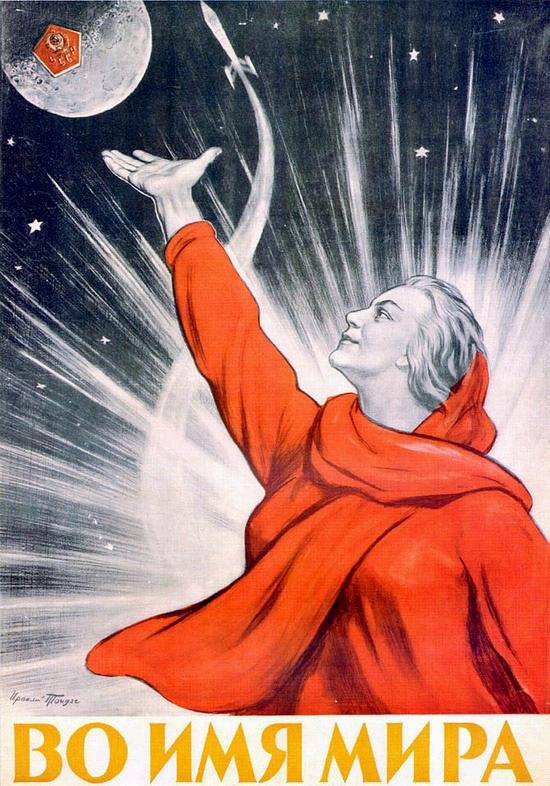

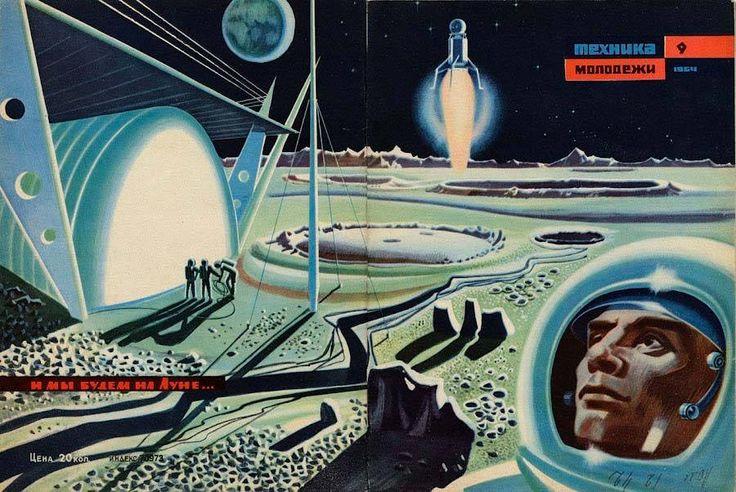
Soviet space propaganda wasn’t just about celebrating rockets or scientific progress. It was a way of shaping how people saw the future. The USSR used space imagery to project a vision of progress that was deeply tied to state ideology. As historian Asif Siddiqi puts it, “the triangulation among socialism, science, and space” gave Soviet space achievements layered meaning (2016, p. 128).
One way this visual ideology circulated was through Tekhnika Molodezhi (Technology for the Youth), a science magazine that launched in 1933. Alongside state issued propaganda posters, it helped shape public imagination around space. It started as a technical journal but eventually became a platform for futuristic art and science fiction, blending imagination with political messaging. At its peak, it reached around 150,000 readers (Mertins, 2020, p. 8).
Their covers often depicted space discoveries, futuristic cities, and advanced technologies. These were not just aesthetic choices, but strategic tools designed to generate excitement for the Soviet space program. As aptly put,
“As cosmonauts rocketed into the cosmos in the 1960s, the Soviet Communist Party and its mouthpieces produced inspirational rhetoric that repeatedly reinforced the link between its achievements in space and the foundational requirement that made the space program possible, socialism” (Siddiqi et al., 2016, p. 127).
Space exploration was not just about discovery, but a symbolic battlefield in the Cold War, where political ideology and scientific ambition merged.
Because there was no single comprehensive source for these materials, I compiled the dataset myself. Images were sourced from a range of archives, museum collections, books, and online repositories. The image collection has been made publicly accessible for future research.
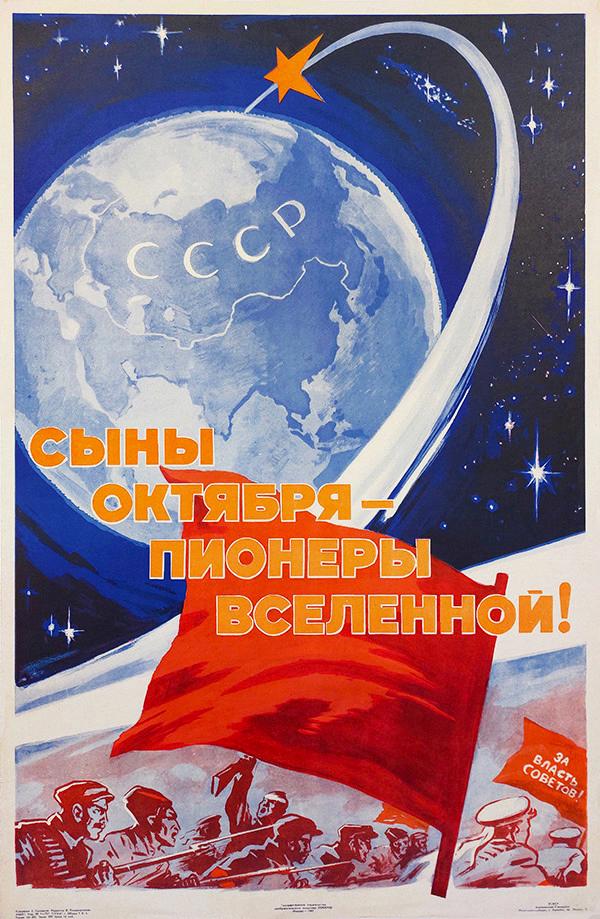
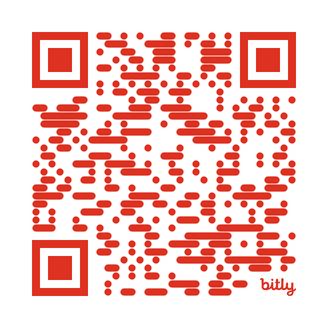

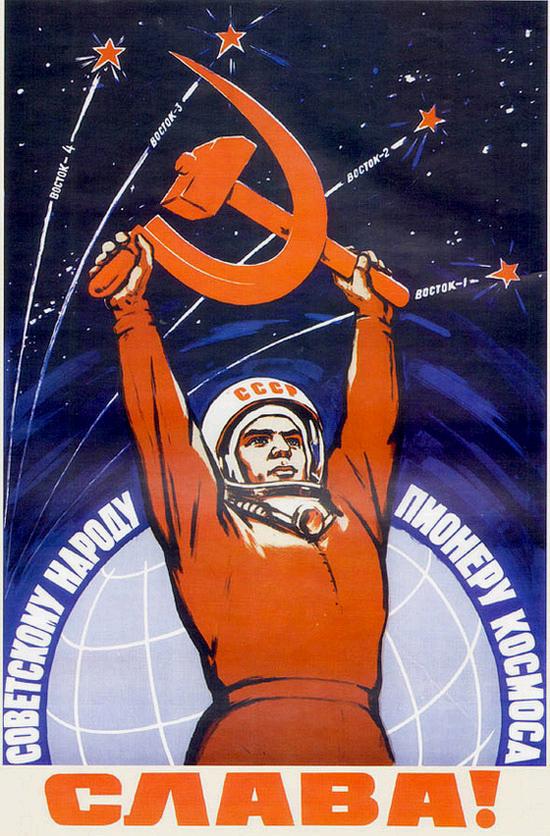
WHAT CRITICAL METHODS BEST SUPPORT BOTH THE ANALYSIS AND CRITIQUE OF COMPUTATIONAL TOOLS?
Inspired by the study by Lin Du et al (2024), which examined Chinese Communist visual propaganda, I adapted their method of using computer vision tools to study ideological messaging, but applied it to a different context While they used object detection and tracking, I chose to cluster full images using ResNet-50, focusing on overall visual composition and style ResNet-50, a convolutional neural network (CNN), is commonly used in cultural institutions to group artworks by artist, genre, or style, detecting visual details like brush strokes, color, and composition (Surapaneni et al., 2020, p. 3). It was well-suited for my goal to analyze how Soviet space imagery uses visual design to convey ideological messages.
But following critiques from Rawson & Muñoz (2019), I recognize the risk of machine learning flattening complex materials into simplified patterns. Tools like UMAP and K-means group images based on mathematical similarity, potentially flattening ideological nuance. My use of ResNet-50 and clustering methods highlights stylistic and thematic patterns across Soviet space propaganda but does not inherently preserve the ideological intent embedded in these images.
This study is also informed by D’Ignazio & Klein’s 7 Principles of Data Feminism and the Feminist Data Manifest-No, both of which challenge the assumption that computational analysis is neutral (Cifor et al., 2019). As they asser t, “data are not neutral or objective. They are the products of unequal social relations” (p. 18).
In the case of Soviet propaganda, these visuals were deliberately designed to shape ideological narratives, yet machine learning classifies them based purely on visual similarity, detached from their political intent. I use Data Feminism’s call to “consider context” to ensure that computational findings remain grounded in historical interpretation (D’Ignazio & Klein, 2020, p. 18).
Machine learning (ML) tools like ResNet-50 are often treated as neutral, but they’re shaped by the data they’re trained on ResNet-50 was trained using ImageNet, a massive dataset rooted in Western, commercial, and Anglophone classifications (MATLAB, n d ; Papers With Code, n d ) Though widely used, ImageNet has drawn criticism for encoding racialized, gendered, and offensive labels (Crawford & Paglen, 2019)
This becomes especially relevant when applying ML to ideologically distinct material like Soviet propaganda Here, I draw on Mashinka Firunts Hakopian’s concept of algolinguicism, which critiques how algorithmic systems privilege dominant worldviews, limiting representation (Hakopian, 2021) While focused on language, I extend her framing to the visual: machine learning reads Soviet images through assumptions it wasn’t built to understand and is shaped by different logics, politics, and cultural norms
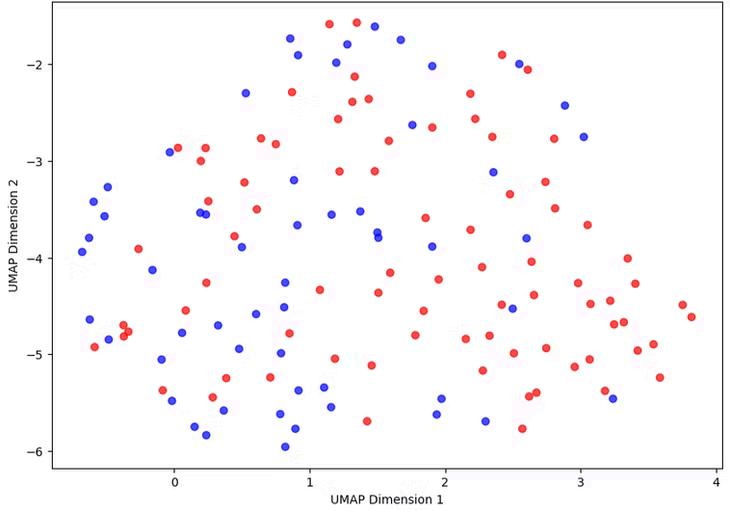
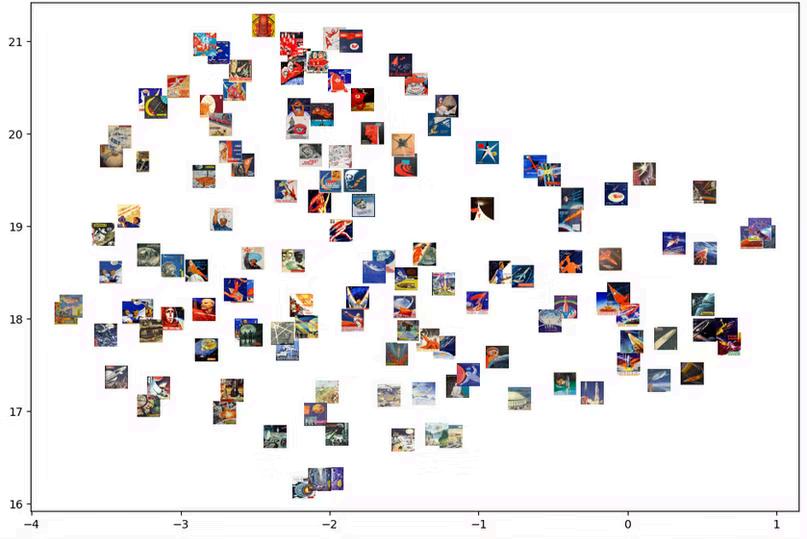
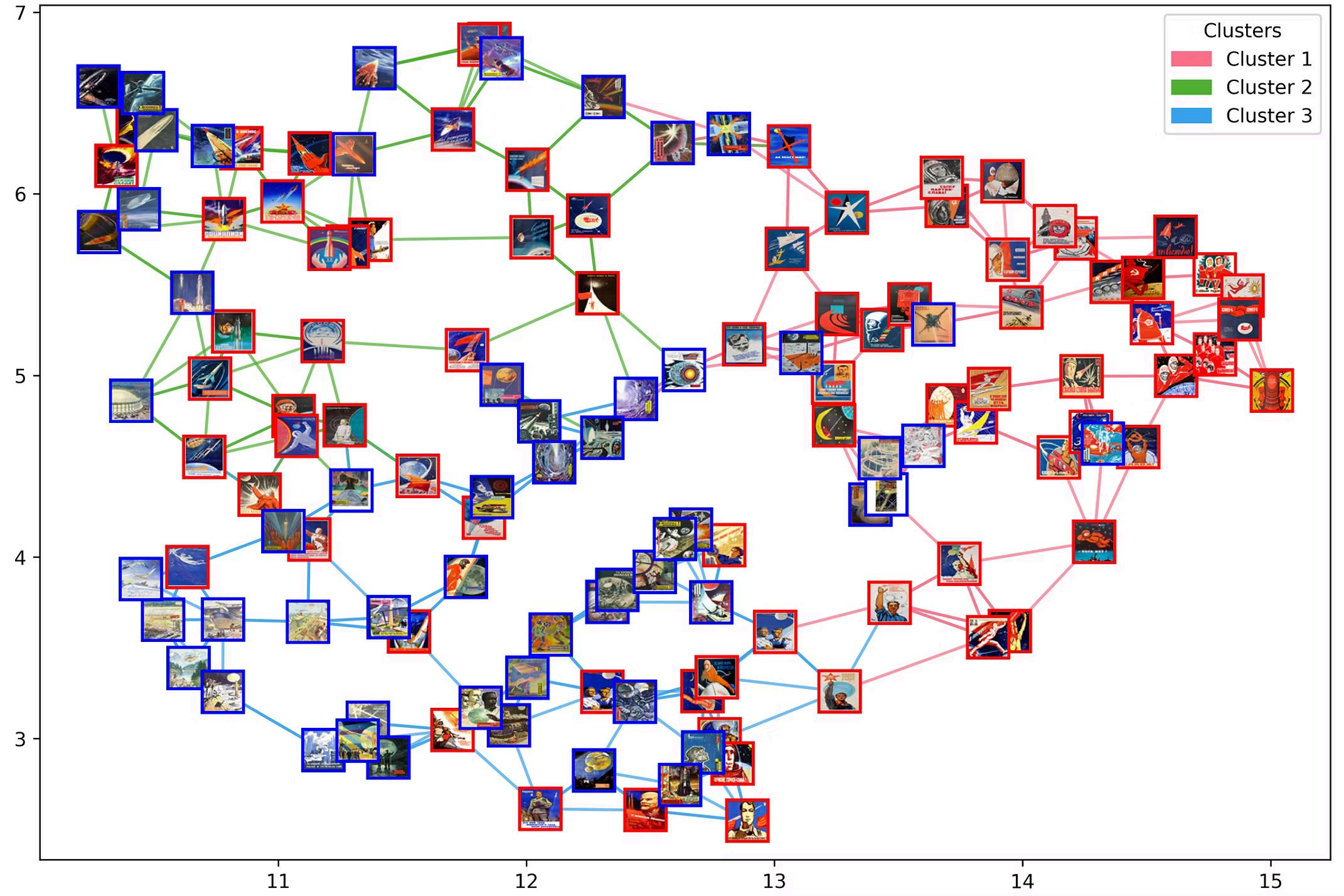
Using Python, I applied machine learning and data visualization techniques to analyze patterns in Soviet space posters and Tekhnika Molodezhi magazine covers, examining how visual styles varied across the two formats.
In order for a computer to be able to “see” images, I used a pre-trained ResNet-50 machine learning model to translate visual features, such as colors, textures, and composition, into numerical data.
To turn those details into something easier to interpret and visualize, I used a technique called UMAP to condense all image data into 2 dimensions. This step created a visual map, where images that are more ‘similar’ are positioned closer together in 2D space. After, I embedded images to their plot points using UMAP.
Next, I used K-Means clustering to identify distinct visual groupings.
Connection lines were made using KDTree nearest-neighbor analysis, which connected each image to its five closest (‘similar’) images. After the different clusters were created and grouped, I added color borders around each image:
State-issued posters Magazine covers
Then, I isolated each cluster to review the images that were grouped together. By segmenting each cluster label, I could visually analyze each grouping.
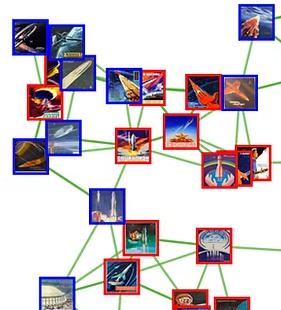
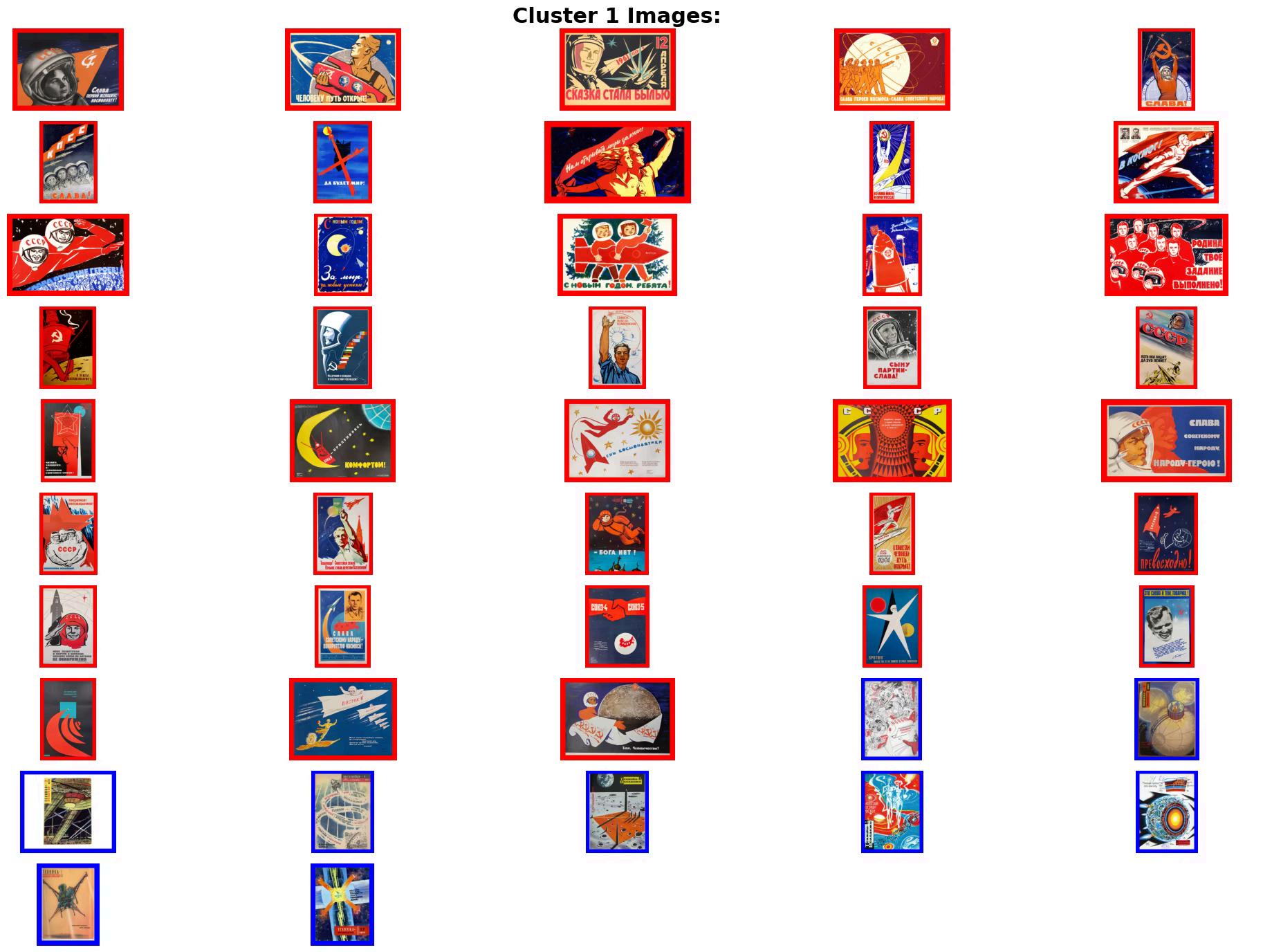
This first cluster is dominated by images of cosmonauts, reinforcing how central human figures were to Soviet space propaganda. The Soviet space program relied not only on technological achievements but also on constructing charismatic figures who could embody its ideological vision. As Siddiqi explains, "the discourse of socialism, science, and space needed key figures to humanize the Soviet surge into the cosmos" (Siddiqi et al., 2016, p. 128). The most recognizable of these figures was Yuri Gagarin, who on April 12, 1961, was the first human to entire space (Andrews & Sidiqi, 2011, p. 15). His image became synonymous with Soviet space triumph and was carefully shaped to present a cheerful, heroic vision of the Soviet future, replacing the bureaucratic figures of earlier Soviet iconography (Andrews & Siddiqi, 2011, p. 15). In this cluster, his image appears approximately 12 times. Propaganda featuring USSR cosmonauts in space was both “patriotic and political” (BBC News, 2015). The machine learning models clustering of these cosmonaut images highlights the repetition of visual motifs that were used and reinforced in soviet posters. Cosmonauts in this cluster are smiling or gazing upward, backdropped by space backgrounds. While the Tekhnika Molodezhi covers in this cluster don't feature cosmonauts, they do feature essential space technology, such as rockets and satellites, the infrastructure that made human spaceflight possible.
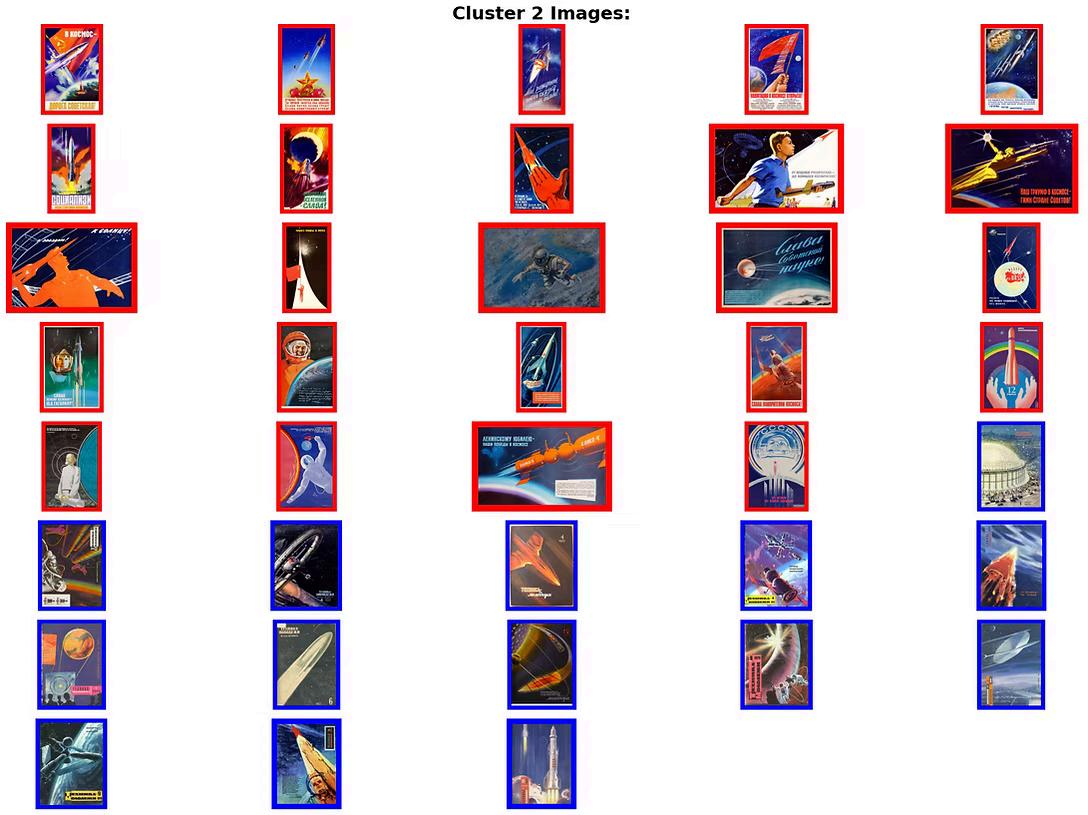
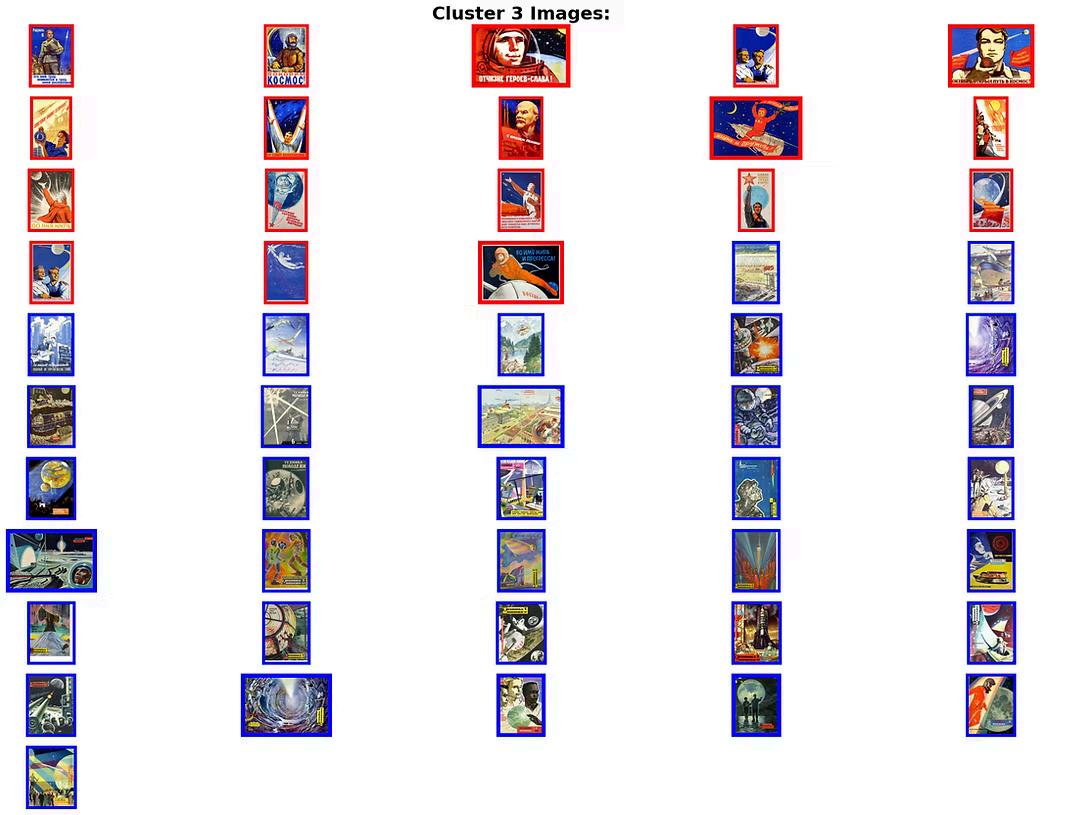
Cluster 3 seems to shift to a more speculative, future imagination of space exploration. The majority of images in this cluster are magazine covers and focus on everything from space stations, cosmic landscapes, to different sorts of abstract depictions of scientific advancements. This theme showcases more Tekhnika Molodezhi covers which aligns with Soviet efforts to “forge a bond between popular youth culture and official forms of ideology” (Andrews, 2016, p. 120). As Soviet Space Graphics put it, "Throughout the entire period, Soviet citizens lived vicariously through the images they consumed … To enter into the world of space travel as a scientist, inventor or cosmonaut was considered among the highest professional achievements – and this aspiration was perpetuated through the magazines that everyone read.” (Mertins, 2020, p. 11). These speculative visuals weren’t just about imagining the future. Instead, they created an emotional connection to the Soviet space program, reinforcing the idea that scientific progress would transform both the individual, and the nation.
The ResNet-50 clustering of these images highlights the visual strategies used to capture the attention of young audiences. Unlike the second cluster which was grounded in existing technology, this grouping showcases more of concepts, optimism, and utopian sorts of imagination. By creating imaginative space imagery, the USSR positioned space as a site of endless possibility.

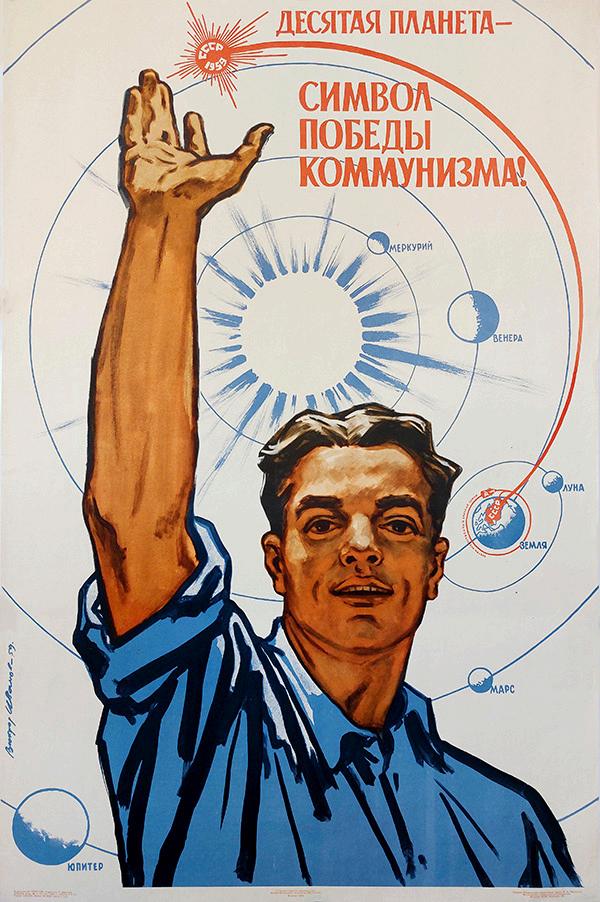
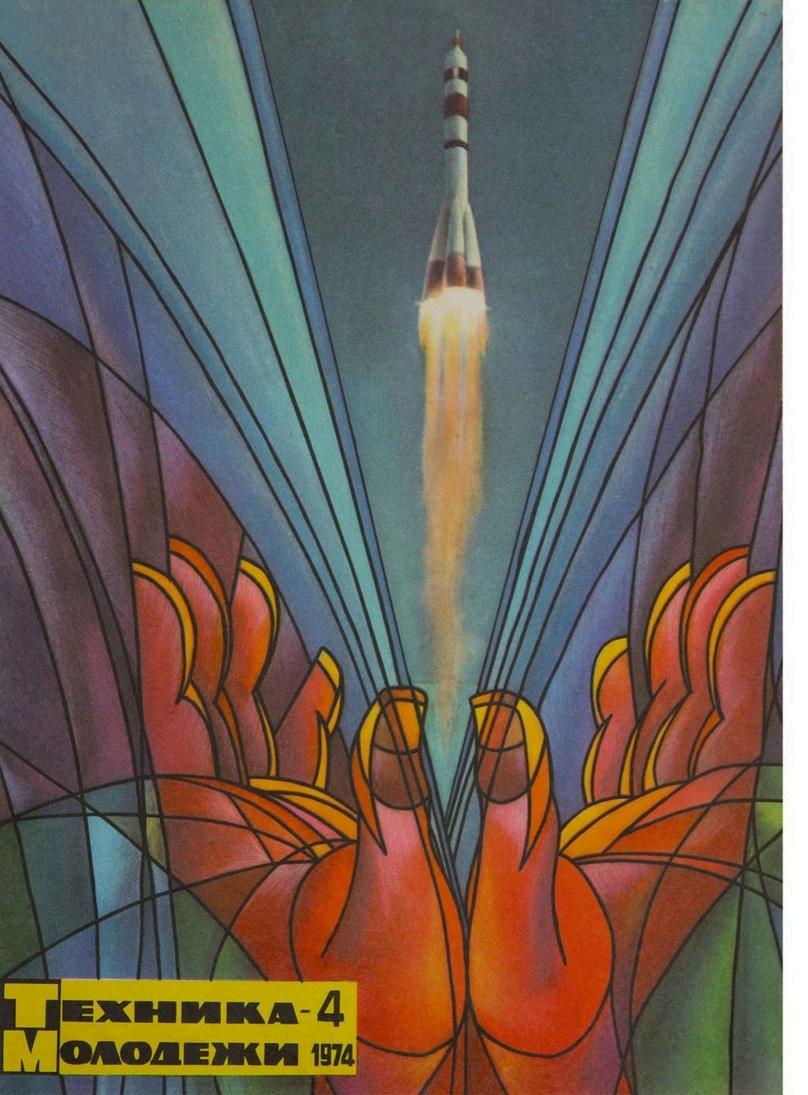




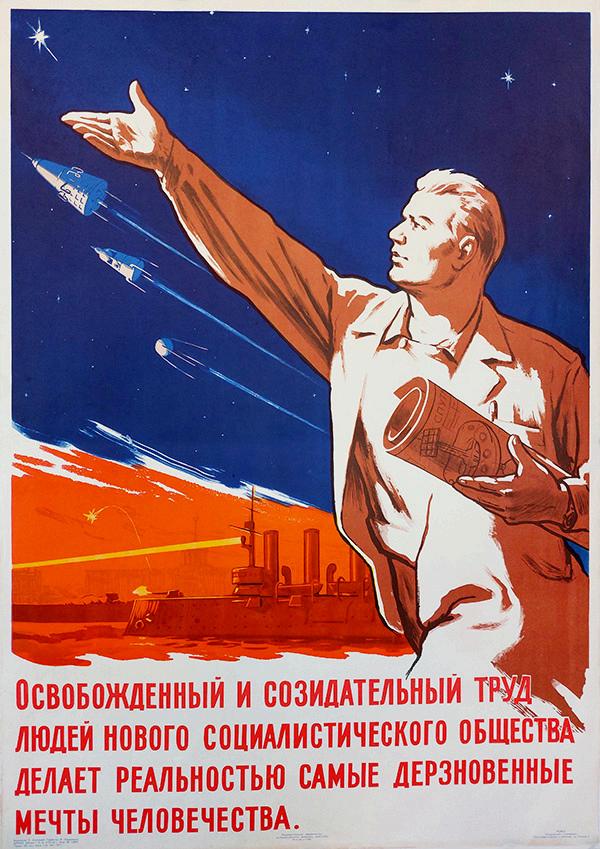




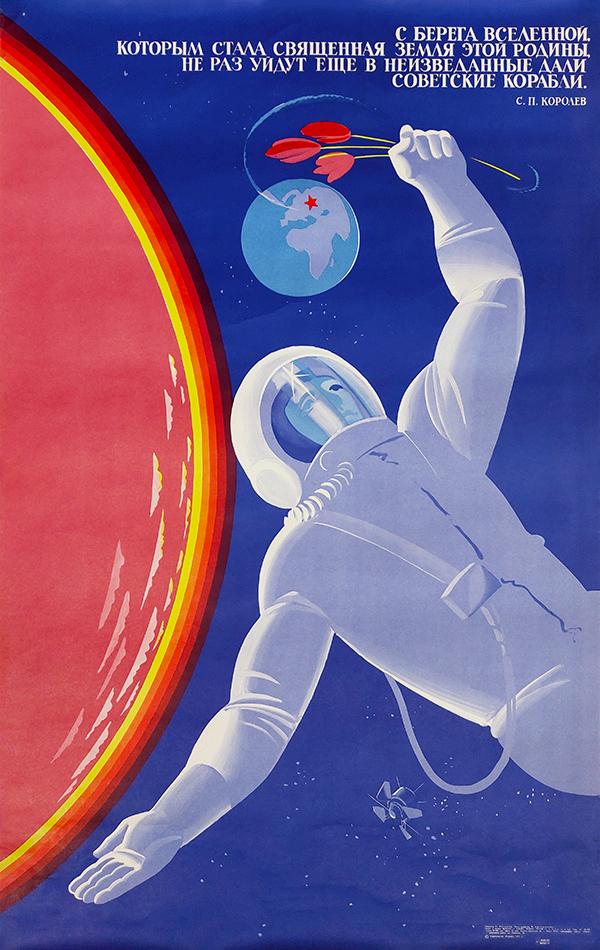
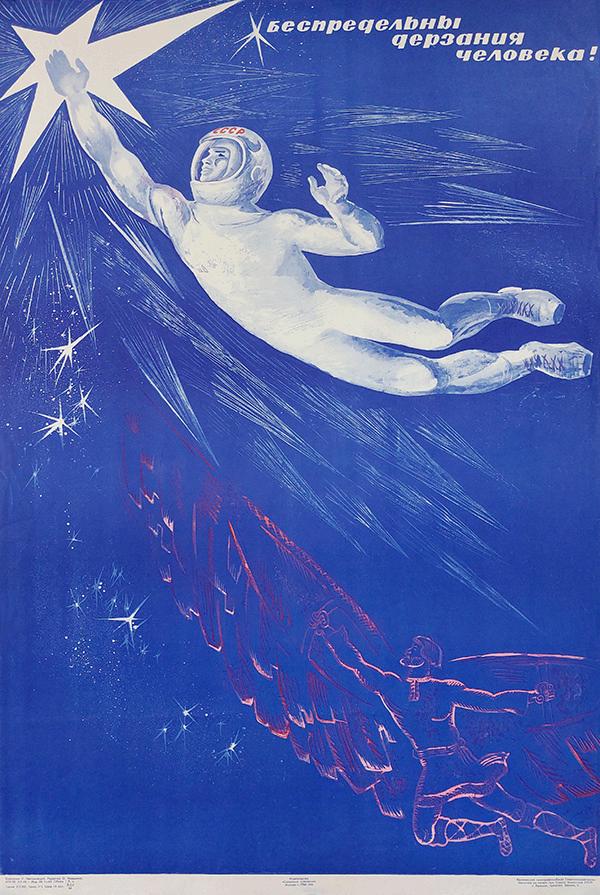
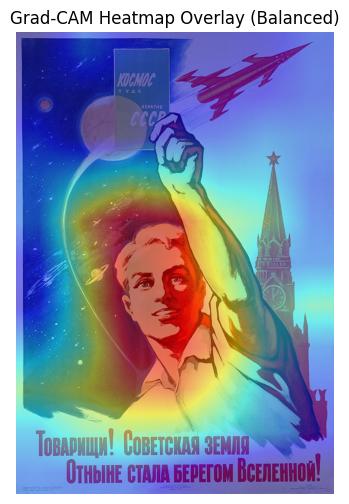
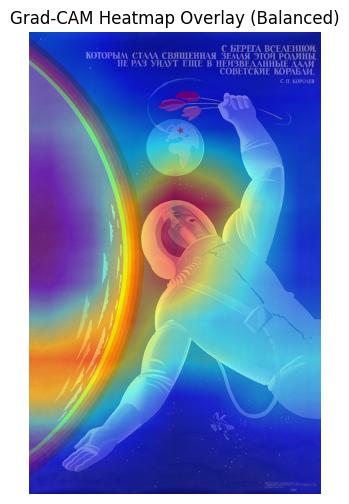
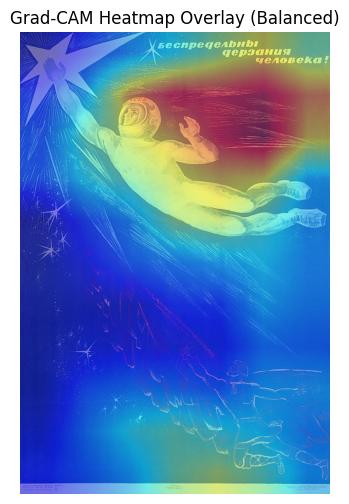
Grad-CAM is a tool that visualizes what parts of an image a model is using to make decisions. It creates heatmaps that highlight areas of highest influence, offering a glimpse into the otherwise opaque “thinking” of the machine (Surapaneni et al., 2020).
For this first cluster, the heatmaps reveal that the model consistently prioritized human faces. Interestingly, the cosmic landscapes and other elements such as curved shapes and movement, are not as highly prioritized as foreground figures. This seems to suggest that these models detect key compositional elements but lack contextual awareness. In the case of the query image, it seems like the flag itself may have been interpreted as a face or it was just the strong red color that contributed to the selection of neighboring images.
I wanted to further explore how the model would handle a cluster not focused on humans and selected an image featuring a clear spacecraft, and ran it through the same process.
The heatmaps seem to suggest that the model may prioritize highcontrast and human faces, while not strongly considering background context. In Image 1 and 2, the focus is on the rocket body while in Image 2, the cosmonaut’s face draws the most attention, suggesting that human figures hold the strongest visual weight. Image 3 highlights the satellite’s solar panels and magazine title, overlooking the recurring curved planet motif across the images. So, while the clustering of images makes sense thematically, the Grad-CAM heatmaps show that the model is not consistently focusing on the same elements across images.


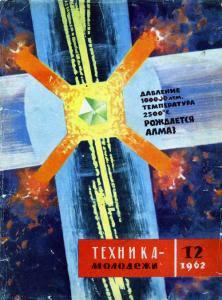
Machine learning helped organize visual patterns across Soviet space propaganda, grouping images that shared features like color, faces, and composition But recognizing these patterns is not the same as understanding meaning or context.
While the clusters initially appeared to reflect differences between state-issued posters and magazines, they ultimately revealed more about the model’s visual priorities more than the propaganda’s message.
One main limitation of this project was its dataset size. With fewer
than 200 images, the model’s ability to surface broader patterns was limited. Another key limitation is that ResNet-50 was not trained on Soviet imagery Without that cultural context, it’s hard to know how its groupings might have changed or what kinds of meaning were lost in the process.
Still, this experiment suggests that, with proper retraining and oversight, machine learning could support archivists and curators in organizing or spotting patterns across large visual collections. But its usefulness depends entirely on how critically and contextually it’s used
Andrews, J. T. (2016). Inculcating Materialist Minds: Scientific Propaganda and AntiReligion in the USSR During the Cold War. In P. Betts & S. A. Smith (Eds.), Science, Religion and Communism in Cold War Europe. St Anthonys. https://doi.org/10.1057/978-1-137-54639-5
Andrews, J. T., & Sidiqi, A. A. (2011). Into the Cosmos: Space Exploration and Soviet culture. In Choice Reviews Online (Issue 06, pp. 49–3241). University of Pittsburgh Press. https://doi.org/10.5860/choice.49-3241
BBC News. (2015, September 19). Posters of the golden age of Soviet cosmonauts. https://www.bbc.com/news/magazine-34281621
Cifor, M., Garcia, P., Cowan, T. L., Rault, J., Sutherland, T., Chan, A., Rode, J., Hoffmann, A. L., Salehi, N., & Nakamura, L. (2019). Feminist Data Manifest-No. https://www.manifestno.com/
Crawford, Kate, and Trevor Paglen. “Excavating AI.” Excavating AI. The AI Now Institute, NYU, September 19, 2019. Accessed April 6, 2025. https://excavating.ai/.
D’Ignazio, C., & Klein, L. F. (2020). Data Feminism. In The MIT Press eBooks. https://doi.org/10.7551/mitpress/11805.001.0001
Du, L., Le, B., & Honig, E. (2023). Probing Historical Image Contexts: Enhancing Visual Archive Retrieval through Computer Vision. Journal on Computing and Cultural Heritage, 16(4), 1–17. https://doi.org/10.1145/3631129
Hakopian, M. F. (2021, October 21). A New AI Lexicon: Algolinguicism. AI Now Institute. Retrieved April 6, 2025, from https://ainowinstitute.org/publication/a-new-ailexicon-algolinguicism-2
MATLAB. (n.d.). Resnet50. Retrieved April 1, 2025, from https://www.mathworks.com/help/deeplearning/ref/resnet50.html
Mertins, D. (2020). Soviet Space Graphics: Cosmic Visions from the USSR. Phaidon Press.
Schwab, K. (2018, July 9). The Secret History Of Russia’s Most Recognizable Brand. Fast Company. Retrieved March 12, 2025, from https://www.fastcompany.com/90167789/the-secret-history-of-russias-mostrecognizable-brand
Siddiqi, A., Betts, P., & Smith, S. A. (2016). Tsiolkovskii and the Invention of “Russian Cosmism”: Science, Mysticism, and the Conquest of Nature at the Birth of Soviet Space Exploration. In Science, Religion, and Communism in Cold War Europe. St Antony’s. https://doi.org/10.1057/978-1-137-54639-5
Surapaneni, S., Syed, S., & Lee, L. Y. (n.d.). Exploring Themes and Bias in Art using Machine Learning Image Analysis. In IEEE Xplore. 2020 Systems and Information Engineering Design Symposium (SIEDS), Charlottesville, VA, United States of America. https://10.1109/SIEDS49339.2020.9106656.